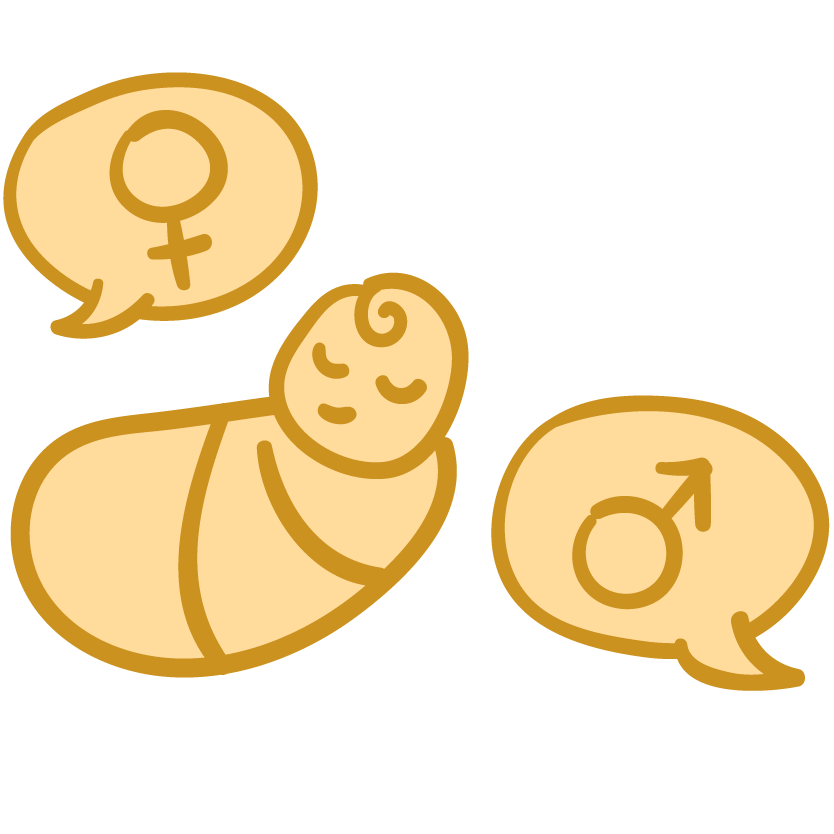Gender is the way we feel, experience, identify and express ourselves as either male, female, both, neither or anything in between. Gender is not just one part of us, it has to do with our body, our identity and our expression.
In North American society, there are strong expectations of the way you are supposed to look and act based on your gender. Some examples are the type of clothing you are expected to wear, the type of activities you are expected to like or the type of career you are expected to have. These expectations are called gender norms and/or gender roles. Gender norms and roles can be extremely limiting to people and are often very unrealistic. People can be picked on, teased or bullied for not fitting into these strict gender roles, and that is never okay. LGBTQ+ communities often question and challenge these rigid concepts. Remember that you have the right to identify with whatever gender feels good to you.
Assigned Sex at Birth
Sex at birth or assigned sex at birth refers to the biological and physical characteristics used to label people as male, female or intersex. Examples of these biological characteristics are internal and external sex organs, hormones and chromosomes.
Some people think that sex and gender as the same thing. In reality, our gender and our sex are two distinct parts of ourselves. Our sex at birth refers to the biological characteristics that are used to label people as male, female or intersex. Our gender refers to the way we feel, experience and express ourselves as either male, female, both, neither or anything in between. Your sex and gender can overlap or can be completely different from one another. Your assigned sex at birth does not define your gender.
Intersex is when a person has sexual characteristics that are not definitively “male” (XY, with a penis and testicles) or “female” (XX, with a vulva, vagina and ovaries). Sexual characteristics may include chromosomes, genitals, reproductive organs and hormones. Someone who is intersex can identify with any gender or sexual orientation.
For more information, check out: Rainbow Health Ontario, Intersex Health
Gender Identity
Gender identity is the way you feel, experience and think about your own gender, whether you identify as a woman, a man, both, neither, or anything in between. When you're born, someone assigns your gender, usually done by a healthcare provider. Your gender can align with your assigned sex at birth which is called cisgender. Or, your gender can be different from your assigned sex at birth which is called transgender.
Gender identity can change and shift over time. The most common gender identities are man and woman and sometimes people think that these are the only two types of gender that exist. In reality, gender is a spectrum, and people can identify with whatever feels good to them. Everyone should have the right to identify with the gender of their choice.
Gender expression is the way a person outwardly presents and expresses their gender in terms of physical appearance, clothing, voice, pronouns, and other aspects. Gender expression usually has to do with how a person looks and acts.
Gender expression is typically defined as masculine or feminine but doesn’t have to be. Another term that can be used is androgynous, which means not distinctively masculine or feminine. Some people may express their gender in a way that matches their sex assigned at birth while others choose not to. This may be related to their sexual orientation and/or gender identity or it may not.
Gender expression is something that can change over time. Everyone should have the right to express their gender in a way that feels good to them.
Transgender is when someone’s gender is different from the sex they are assigned at birth. For example, someone who is assigned male at birth and who identifies as a woman. Trans can also be used as an umbrella term to include anyone who is gender variant and non-cisgender.
Cisgender is when someone’s gender aligns with the sex they are assigned at birth. For example, someone who is assigned female at birth and who identifies as a woman.
Agender is when someone does not have a gender. Being agender will look different for everyone, and so it is important to respect and listen to how each person identifies and the pronouns they use.
Non-binary is a gender identity that goes beyond the gender binary of man/woman. Being non-binary will look differently for everyone and so it is important to respect and listen to how each person identifies and the pronouns they use. Someone may identify as both a woman and a man, as neither a woman nor a man, as both a woman and a non-binary person … the options are endless! Some non-binary folk also identify as trans or trans non-binary, while others do not. Under the umbrella category of non-binary, someone may also or alternatively identify as genderqueer, genderfluid, gender variant or gender non-conforming.
Gender variant is when someone’s gender identity differs from society’s expectations and norms around gender. Their gender identity and gender expression go beyond conventional definitions of a man or a woman.
Genderqueer is when someone’s gender identity exists outside of the gender binary. In a way, the gender is "queered" because it goes against what society thinks is "normal".
Genderfluid is when someone’s gender identity is constantly taking shape or moving. Their gender identity may change over time based on their mood and feelings. Their gender can span across the whole gender spectrum.
Gender non-conforming is when someone’s gender identity does not conform to society’s expectations and norms around gender. Someone who identifies as gender-non conforming may choose to express themselves in a way that challenges conventional definitions of a man and/or a woman.
Gender neutral pronouns are pronouns that are not gender-specific. For example, they/them pronouns can be used to describe a singular person who does not identify as either he/him or she/her. Zie and hir (pronounced zee and here) are alternative gender neutral pronouns; zie replaces he/she and hir replaces him/her.
Each individual, no matter what their gender identity, will have their own preferences when it comes to pronouns. It is important to respect each person’s pronouns, and if you are not sure which ones to use, just ask!
Transitioning
Transitioning is when a person changes their gender expression to better reflect their gender identity. Transitioning could look different for different people, and depends on all kinds of factors, like home life, money, age and safety. For some, it happens gradually over different times of their life; for others, it happens all at once. This could involve many different things such as coming out, changing names, changing pronouns, dressing differently, hormone therapy or getting surgery. Not everyone will go through each stage and there is no end point that must be met. Transitioning will be different for each person; it is totally up to you to decide how much you want to change about your gender expression based on what feels good to you.
If you know someone who’s transitioning, it is important to respect their process and remember that these changes are necessary for them to live authentically.
Gender dysphoria is the distress, anxiety and discomfort that people may feel when their gender identity does not match their sex assigned at birth. Gender dysphoria can be diagnosed by health and/or mental health professionals as a way to help individuals receive the treatment they need to transition. This may happen at any age. Not everyone who experiences a mismatch between their sex assigned at birth and their gender identity will have gender dysphoria.
Gender dysphoria replaced the term “gender identity disorder”. The term was changed to reflect the fact that gender dysphoria is not a mental illness.
Gender-affirming surgery (sometimes called sexual reassignment surgery) is a type of surgery that changes a person’s physical characteristics to better reflect their gender identity. There are many different surgeries that exist that can involve the chest, face, genitals and other areas of the body. Gender-affirming surgery can be necessary for an individual’s well-being and safety, and can alleviate distress and anxiety. Not all trans or gender variant individuals will choose to have surgery.
To find out what type of surgeries exist in Canada, and the process in different provinces, check out:
British Columbia
Ontario
Manitoba
Nova Scotia
Alberta
Quebec
Saskatchewan
New Brunswick
Prince Edward Island
Newfoundland and Labrador
Across Canada
For the Yukon, Nunavut and the Northwest Territories, there is currently a lack of information online regarding gender-affirming surgery. Please consult your doctor or health care practitioner to find out more information.



